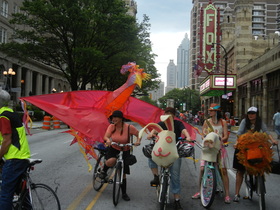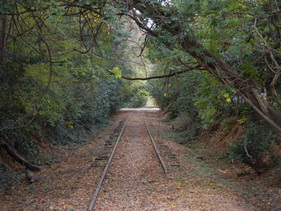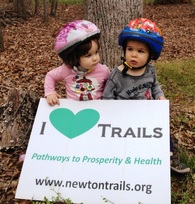Enough teasing, let's finally talk about Tactical Urbanism, as I've been promising. Like the last two posts on Agile and showing vs. telling, this post shares effective ways to bring about change.
My intent is not to cover urbanism as a philosophy, but rather to show how well-chosen short-term (tactical) actions can help achieve long-term (strategic) objectives.
In this context, urbanism refers to a movement formalized in 1993 by the Congress for the New Urbanism. CNU describes itself as "the leading organization promoting walkable, mixed-use neighborhood development, sustainable communities and healthier living conditions."
The term "Tactical Urbanism" was coined in late 2010 when Mike Lydon and other planning professionals gathered in New Orleans for a CNU spinoff called NextGen. During the retreat, Lydon presented personal experiences and other stories about an emerging phenomenon -- communities staging low-cost, tactical interventions to promote and gain traction for long-term visions.
Following that collaboration, through the Streets Plan Collaborative, Lydon and his colleagues published a free, downloadable PDF book in early 2011 titled Tactical Urbanism Volume 1: Short Term Action || Long Term Change. After several online updates, the latest edition coauthored with Anthony Garcia is available now in print through Island Press and various retailers.
Tactical Urbanism is not a single method, but rather an accumulation of proven ideas and successful approaches from around the world. Yet, they all share a similar premise that top-down, centrally managed, large-scale transformation programs often fail to deliver. And many times, low-cost, bottoms-up, incremental actions can move the ball significantly forward.
One example is Open Streets, an event where communities temporarily close streets to automobile traffic, allowing people to use them for walking, bicycling, dancing, playing, and socializing. The idea was inspired in the mid 1970s by Bogota, Colombia's "Ciclovia" -- a weekly event going strong after more than 40 years. Each Sunday, 70+ miles of roadway are closed to car traffic, turning the streets over to an estimated two million people on bikes and/or foot.
My intent is not to cover urbanism as a philosophy, but rather to show how well-chosen short-term (tactical) actions can help achieve long-term (strategic) objectives.
In this context, urbanism refers to a movement formalized in 1993 by the Congress for the New Urbanism. CNU describes itself as "the leading organization promoting walkable, mixed-use neighborhood development, sustainable communities and healthier living conditions."
The term "Tactical Urbanism" was coined in late 2010 when Mike Lydon and other planning professionals gathered in New Orleans for a CNU spinoff called NextGen. During the retreat, Lydon presented personal experiences and other stories about an emerging phenomenon -- communities staging low-cost, tactical interventions to promote and gain traction for long-term visions.
Following that collaboration, through the Streets Plan Collaborative, Lydon and his colleagues published a free, downloadable PDF book in early 2011 titled Tactical Urbanism Volume 1: Short Term Action || Long Term Change. After several online updates, the latest edition coauthored with Anthony Garcia is available now in print through Island Press and various retailers.
Tactical Urbanism is not a single method, but rather an accumulation of proven ideas and successful approaches from around the world. Yet, they all share a similar premise that top-down, centrally managed, large-scale transformation programs often fail to deliver. And many times, low-cost, bottoms-up, incremental actions can move the ball significantly forward.
One example is Open Streets, an event where communities temporarily close streets to automobile traffic, allowing people to use them for walking, bicycling, dancing, playing, and socializing. The idea was inspired in the mid 1970s by Bogota, Colombia's "Ciclovia" -- a weekly event going strong after more than 40 years. Each Sunday, 70+ miles of roadway are closed to car traffic, turning the streets over to an estimated two million people on bikes and/or foot.
In the United States, the Open Streets Project has identified more than 100 documented open streets events. At a low cost in a short amount of time, these festivals demonstrate on a large scale what we were trying to accomplish with the rail trail project mentioned in my last post. Open Streets events provide safe, accessible places for people to experience biking, walking, dancing, skateboarding, and all manner of fun, healthy outdoor recreation. They also prove to civic leaders the public demand for such spaces.

My hometown Atlanta holds several events each year in different neighborhoods under the banner Atlanta Streets Alive. In 2013, I wrote a column saying Let's Go Dancing In the Streets after my personal experiences biking down Atlanta's busiest thoroughfare -- Peachtree Street.
Other Tactical Urbanism interventions with this same spirit include:
These Tactical Urbanism interventions work because these are not just random events. To realize progress towards long-term objectives, these actions are targeted to create the right experiences to change hearts and minds and move a community together towards a now more tangible vision.
Regardless of your mission, Tactical Urbanism and its successes hold useful lessons for all of us. You can tell people what you're trying to do, and maybe a few will follow. But, show them, let them experience it, touch their hearts...
Now you're going somewhere!
Other Tactical Urbanism interventions with this same spirit include:
- PARK(ing) Day -- temporarily converting on-street parking into park-like spaces.
- Intersection Repair -- using traffic cones and other temporary structures to show how road space could be reallocated for greater safety and access.
- Build a Better Block -- where streets are temporarily transformed using food carts, pop-up cafes, tables, temporary bike lanes, and other low-cost items to demonstrate alternative designs for the space. (For a great example, read about the the Hampline on Broad Avenue in Memphis.)
- Pavement to Plazas -- an intervention made famous on Memorial Day weekend 2009, when New York City transformed Times Square overnight into a make-shift pedestrian plaza free of cars. The proof of concept has since been made permanent.
- Little Free Library -- a grassroots movement of the sharing economy, wherein private citizens create small boxes (usually decoratively painted) and fill them with used books and the motto "Take a Book, Return a Book."
These Tactical Urbanism interventions work because these are not just random events. To realize progress towards long-term objectives, these actions are targeted to create the right experiences to change hearts and minds and move a community together towards a now more tangible vision.
Regardless of your mission, Tactical Urbanism and its successes hold useful lessons for all of us. You can tell people what you're trying to do, and maybe a few will follow. But, show them, let them experience it, touch their hearts...
Now you're going somewhere!




 RSS Feed
RSS Feed